Giovanni Pierluigi da Palestrina
The Missa Papae Marcelli and its context
The Missa Papae Marcelli by Giovanni Pierluigi da Palestrina is a masterpiece that is surrounded by a fascinating legend: the work is claimed to have saved polyphonic music in the Catholic liturgy. It is often associated with the reforms of the Council of Trent. The new edition of the work presents the musical text in its oldest form. The following article takes a critical look at the creation of the legend.
Palestrina and the Missa Papae Marcelli
As so often, the composition date of the mass is unknown. It must have been drafted within a broad time range between 1555 and 1567. 1555 was the year of the short pontificate of Pope Marcellus II, born Marcello Cervini. Elected to the papal throne on 9 April, he remained in post for only 23 days until his death during the night between 30 April and 1 May.1 1567 is the year of the print publication of the Missarum liber secundus, the second collection of masses by Palestrina, which concludes with the Missa Papae Marcelli. This collection is dedicated to “Philippo Austriaco regi catholico et invicto”, Philip II King of Spain, and contains, in addition to our mass, six other masses (four with four voices and two with five).2
Further information comes from manuscript 22 of the Sistine Chapel, in which the mass is copied, although without a title. It is a large in-folio volume that contains six masses, three of which are by Palestrina, all for six voices. In the “Q” of the Qui sedes of the Credo of the Missa Benedicta es (f. 58v), which precedes the Papae Marcelli, is written the date 1565: it may allude to the year in which that mass was copied, or indeed all three Palestrina masses. This theory cannot be verified, partly because there is another date in the codex, 1568 (f. 37v), in the mass by Robledo that precedes all the masses by Palestrina. However, the fact that two witnesses placed Papae Marcelli in the second half of the 1560s leads us to believe that the mass was composed not long before, and thus well after the death of Pope Marcellus II.
Dr. Francesco Saggio studied musicology at the University of Pavia/Cremona, where he completed his doctorate in 2011 on the madrigals of the four-part ‘Primo libro’ by Philippe Verdelot (1533). He specialises in music of the 16th and 17th centuries, with a focus on poetic-musical forms, critical editions and historiographical perspectives.
Giovanni Pierluigi da Palestrina
Missa Papae Marcelli
Carus 27.906
Within this time frame, Palestrina’s life underwent substantial change.3 In April 1555 Palestrina had been a member of one of the most illustrious (and powerful) musical ensembles in Europe for four months: the Cappella di Nostro Signore, as it was called at the time, i.e. the group of papal choristers, today known as the Sistine Chapel choir. He was accepted due to the support of Pope Julius III, who admitted him to the Chapel without an audition and even though he was married. This good fortune lasted only a short time, since in July of the same year the more rigid Paul IV expelled him because of his married status, though gave him a pension. Palestrina moved into a new position, however, shortly afterwards: on 1 October he was appointed chapel master of St John Lateran, a post he held until August 1560. On 1 March 1561 he took up the post of chapel master in Santa Maria Maggiore, where he remained at least until January 1565. By the time the second book of masses was printed, Palestrina had become chapel master of the Roman Seminary (at least since April 1566), a job to which various temporary positions were added in 1567, such as that of director of the private chapel of Ippolito II d’Este, or as an extra chorister at St John Lateran during Holy Week.
After his dismissal from the Sistine Chapel, he was also then hired to provide new compositions for that Chapel. A contract dated 6 June 1565 specifies the payment of an additional sum over and above the pension that Palestrina already received for compositions “made and to be made”:4 most likely the Missa Papae Marcelli was among these. The coincidence with the date in ms. 22 would support the theory that the mass was composed in that year, perhaps for an in memoriam celebration for the pontiff on the tenth anniversary of his death.
The origin of the myth surrounding the mass dates back to 1607, when the musician and theorist Agostino Agazzari, in his treatise on the basso continuo,5 directly relates the composition of the Papae Marcelli to the issue of the intelligibility of the text in polyphonic works. Although it was then taken up even more decisively by Adriano Banchieri6 and Ludovico Cresolli,7 this cause-and-effect relationship has, however, no historical foundation, except for the temporal coincidence between its composition and the events relating to the Council of Trent.
Palestrina and the Council of Trent
The Missa Papae Marcelli is commonly linked to the positions expressed by the Council of Trent regarding the reform of liturgical and sacred music in general. The documents have been studied extensively,8 and it is now clear that the direct effects of the Council on music were quite limited and restricted to specific situations. In fact, no definitive decision was proclaimed on the attributes of sacred music: this was left to the diocesan synods, which did not act uniformly.9 Only a few prominent figures, such as the Archbishop of Bologna Gabriele Paleotti or the Archbishop of Milan Carlo Borromeo,10 maintained an intransigent attitude. But nothing directly connected to Palestrina.
Even in the prefaces to his editions, the composer never refers to this subject. In the dedication of the Missarum liber secundus, there is a simple reference to “a new way of composing melodies”,11 which has a clear rhetorical feel, difficult to interpret as a precise aesthetic determination dictated by the Council’s requests. It is likely that Palestrina assimilated the post-conciliar climate and that his writing was affected by a new way of conceiving the relationship between text and music in the liturgy, but there is no concrete evidence that the Missa Papa Marcelli was created with this purpose.
The statements by Agazzari and Banchieri on the salvific role of the mass must be read in the cultural context of the early seventeenth century, which was very different from that of the 1560s. According to some scholars, the origin of the myth of Palestrina and the Missa Papae Marcelli relates to the environment of the Jesuits and the attempt to impose the Church of Rome as a model of Catholic Christianity.12 In terms of music, who better than Palestrina, a composer of the pontifical chapel and a Roman through and through, to embody this exemplary role? The theory is corroborated both by Agazzari’s relationship with the Jesuits,13 and by Cresolli’s testimony, as well as by other external factors.14 It cannot therefore be excluded that Agazzari re-evoked the Missa Papae Marcelli purely because it was linked to the image of a “reformer” pope or (perhaps) because it had musical attributes akin to the post-conciliar requests for textual intelligibility (notably the homophonic writing of the Gloria and the Credo). All this regardless of Palestrina’s own wishes.
Palestrina and Pope Marcellus II.
The real question that remains unresolved is the relationship between this polyphonic mass and Pope Marcellus. If, twelve years after his death (and that of two further popes, Paul IV and Pius IV), Palestrina decides to publish it with an explicit title that is nowhere to be found in the manuscript sources, it means that the relationship between the mass and the pope had to be so close that it could neither be ignored nor forgotten. In fact, no other composition in Palestrina’’s vast catalogue bears the name of a historical figure in the title, even when it is evidently in the nature of an homage.15
Marcellus II’s interest in liturgical music is in fact demonstrated by a single event, that has also been recalled many times, which occurred during the only Holy Week he presided over as pontiff.16 On 12 April 1555, during the Good Friday rites, he noticed that the singers not only recited the sacred texts without reverence, but that they sang as if the songs were joyful, completely inappropriate for that liturgical day. The pope summoned the singers and told them that in the days of the Passion they should adopt a style of singing more suited to the mournful nature of that period and that they should perform the songs in such a way “that what they said could be heard and understood”.17 We do not know if Palestrina was among the singers summoned by the pope – it is likely since he was a current member of the Chapel – but it is certain that the wishes expressed by the pope must have been disseminated among all the Sistine Chapel musicians.
The relationship between Pope Marcellus and music is also mentioned in a letter dating back to c.1574 by Bernardino Cirillo,18 author of another, earlier, famous missive on the abuse of sacred music, whose themes would have aroused interest in the pope.19 It is therefore likely that Marcellus II had the issues of liturgical music at heart, but there is certainly no specific evidence to suggest that our mass was composed (or even performed) during his brief papacy.20
The title Missa Papae Marcelli uses the genitive case to express belonging: Pope Marcellus’s Mass. However, instead of “Mass for Pope Marcellus”, the wording should be interpreted as “Mass in memory of Pope Marcellus”. This reading would also explain its composition after Cervini’s papacy and a contrapuntal texture congruent with the times, when the outcome of the Council had now taken over the drive towards a more conscious liturgical music, which Marcellus II himself had advocated.
All the elements examined here lead to the conclusion that Palestrina wrote this mass around the 1560s to commemorate Pope Marcellus years after his death. The musical style he uses is affected by the post-conciliar climate that was spreading in those years, but without an explicit intention to comply with its strictest demands. In this historical-cultural context, in which the Jesuits played a leading role, the myth of Palestrina, savior of liturgical polyphony, grew, and his Missa Papae Marcelli seemed the most suitable composition to consolidate this reconstruction.
Ultimately, what remains is a musical masterpiece, which rightly deserves to be performed and appreciated, especially in light of the critical insights offered by this new edition.
[1] On Marcello Cervini see Giampiero Brunelli, s.v. “Marcello II, papa”, in Dizionario Biografico degli Italiani, vol. 69 (2007), https://www.treccani.it/enciclopedia/papa-marcello-ii_%28Dizionario-Biografico%29/ (in Italian).
[2] See Giovanni Pierluigi da Palestrina, Missarum liber secundus, 2 vols., ed. Francesco Luisi (Rome: Comitato per l’edizione nazionale delle opere di Giovanni Pierluigi da Palestrina, 2011).
[3] On the author’s biography see Marco Della Sciucca, Giovanni Pierluigi da Palestrina (Palermo: L’Epos, 2009) and Rodobaldo Tibaldi, s.v. “Pierluigi da Palestrina, Giovanni, detto anche ‘il Palestrina’ ”, in Dizionario Biografico degli Italiani, vol. 83 (2015), https://www.treccani.it/enciclopedia/pierluigi-da-palestrina-giovanni-detto-anche-il-palestrina_%28Dizionario-Biografico%29/ (in Italian).
[4] Alberto Cametti, Palestrina (Milan: Bottega di Poesia, 1925), 106.
[5] Agostino Agazzari, Del sonare sopra ’l basso con tutti li stromenti (Siena: Domenico Falcini, 1607), 11. Eng. trans. in Palestrina, Pope Marcellus: An Authoritative Score, ed. Lockwood, 28–9.
[6] Adriano Banchieri, Conclusioni nel suono dell’organo (Bologna: eredi di Gio. Rossi, 1609), 18–9. Eng. trans. in Palestrina, Pope Marcellus: An Authoritative Score, ed. Lockwood, 9, footnote.
[7] Ludovici Cresollii armorici e societate Iesu Mystagogus de sacrorum hominum disciplina (Paris: Sebastiani Cramoisy, 1629), 627. Eng. trans. in Palestrina, Pope Marcellus: An Authoritative Score, ed. Lockwood, 30.
[8] See in particular Bonifacio Giacomo Baroffio, “Il Concilio di Trento e la musica”, in Musica e liturgia nella riforma tridentina: Trento, Castello del Buonconsiglio 23 September–26 November 1995, eds. Danilo Curti and Marco Gozzi (Provincia autonoma di Trento: Servizio Beni Librari e archivistici), 9–18; Craig A. Monson, “The Council of Trent Revisited”, Journal of the American Musicological Society, no. 55 (2002): 1–37; Jeffrey Kurtzman, “The Effect on Italian Liturgical Music of the Council of Trent (1562), the Breviarium Romanum (1568), and the Caeremoniale Episcoporum (1600)”, Studies in Sixteenth- and Seventeenth-Century Italian Sacred Music (Farnham, Surrey: Ashgate Publishing, 2014), 1–50; Chiara Bertoglio, Reforming Music. Music and the Religious Reformations of the Sixteenth Century (Berlin and Boston: De Gruyter, 2017), chaps. 8 and 9.
[9] Monson, “The Council of Trent Revisited”, 18.
[10] Bertoglio, Reforming Music, 402–5; Monson, “The Council of Trent Revisited”, 22–4. Borromeo, together with Cardinal Vitellozzo Vitelli, participated in the inquiry of 28 April 1565, in which some masses were sung to verify “if the words could be understood”. Despite the coincidence with the date on the Sistine Chapel manuscript, there is no evidence that the Missa Papae Marcelli was performed in that context. Cf. Oscar Mischiati, “‘Ut verba intelligerentur’: circostanze e connessioni a proposito della Missa Papae Marcelli”, in Atti del convegno di studi palestriniani 28 settembre–2 ottobre 1975, ed. Francesco Luisi (Palestrina, 1977), 415–26, here: 424–6.
[11] The entire dedication is published here on [complete with page number].
[12] First, Pierre Gaillard, “Histoire de la légende palestrinienne”, Revue de Musicologie, no. 57/1 (1971): 11–22 and, more recently, Christian Thomas Leitmeir, “Catholic Music in the Diocese of Augsburg c.1600: A Reconstructed Tricinum Anthology and Its Confessional Implications”, Early Music History, no. 21 (2002): 117–73, here: 130–2.
[13] Gaillard, “Histoire de la légende palestrinienne”, 12.
[14] Leitmeir, “Catholic Music”, 130–2.
[15] As in the case of the Missa Ecce Sacerdos Magnus, which opens the Liber primus missarum (1554), and is dedicated (as is the entire collection) to Pope Julius III.
[16] Mischiati, “ ‘Ut verba intelligerentur’ ”, 420–3.
[17] The event is recorded in the diary of the secretary Angelo Massarelli and was published later in the Acts of the Tridentine Council. Cf. Bertoglio, Reforming Music, 396–7.
[18] Palestrina, Pope Marcellus Mass: An Authoritative Score, ed. Lockwood, 26–7.
[19] Chiara Bertoglio, “Cats, bulls and donkeys: Bernardino Cirillo on 16th-century church music”, Early Music, no. 45/4 (2017): 559-72.
[20] As argued in some historical biographies, cf. Cametti, Palestrina, 97.


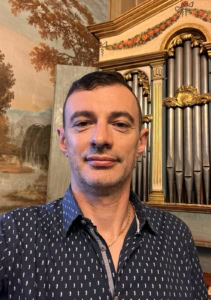
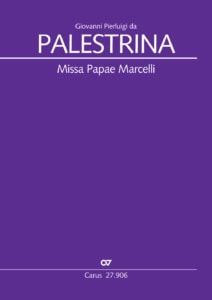
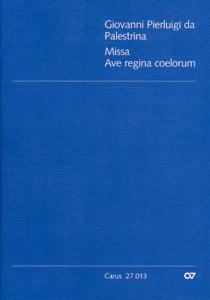
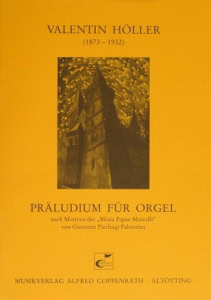
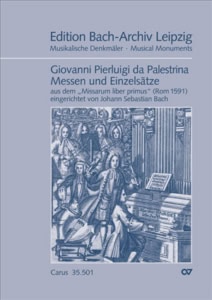


Leave a Reply
Want to join the discussion?Feel free to contribute!